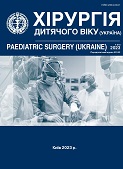Pathomorphological and morphometric features of acute appendicitis in children with type I diabetes mellitus
DOI:
https://doi.org/10.15574/PS.2023.81.31Keywords:
acute appendicitis, peritoneum, type I diabetes mellitus, children, appendix, pathomorphological changesAbstract
Metabolic disorders caused by chronic hyperglycemia in the gastrointestinal tract of patients with type I diabetes mellitus (T1DM) not only affect natural course of this disease but also modify clinical course of concomitant abdominal purulent-inflammatory diseases in children due to changes of the internal intestinal wall.
Purpose - to analyze pathomorphological and morphometric features of acute appendicitis in children with T1DM.
Materials and methods. We carried out a pathomorphological and morphometric case-control study of the surgical specimens (appendices and fragments of the peritoneum). Two groups were created: the Group I (n=11) - patients with acute appendicitis, peritonitis and T1DM; the Group II (n=24) - patients with acute appendicitis, peritonitis but without T1DM. Statistical analysis was performed using software package STATISTICA v.10.0 (StatSoft, USA).
Results. There were signs of diabetic angiopathy in the Group I and a significant number of inflammatory cells, represented by a large number of segmented nuclear leukocytes - 431±18.2 in 1 mm2, plasma cells - 146±11.13 in 1 mm2, lymphohistiocytic elements - 196±23,32 in 1 mm2. The density of the inflammatory cell infiltrate was 773±36.2 cells in 1 mm2.
Morphometric features of the Group II are as follows, number of segmented nuclear leukocytes - 228±15,7 in 1 mm2, plasma cells - 112±10,41 in 1 mm2, lymphohistiocytic elements - 132±21,2 in 1 mm2. The density of the inflammatory cell infiltrate was 773±36.2 cells in 1 mm2.
Conclusions. There is an increase in the density of the inflammatory cell infiltrate, the number of neutrophils, plasma cells, and lymphohistiocytic elements in samples of appendices and peritoneum in children with acute appendicitis and T1DM in comparison with the Group II (p˂0.001). Furthermore, those specimens feature presence of hyalinosis, thickening of the vascular wall and partial obliteration of small caliber vessels.
In the Group II (patients without T1DM), the parietal and visceral peritoneum had a large number of inflammatory elements and presence of macrophage elements upon normal histological structure of the microcirculatory vessels.
The research was carried out in accordance with the principles of the Helsinki Declaration. The study protocol was approved by the Local Ethics Committee of participating institution. The informed consent of the patient was obtained for conducting the studies.
No conflict of interest was declared by the authors.
References
Bilinskyi I. (2020). Morphological Characteristics of Changes in the Duodenal Wall Within 14-56 Days of the Development of Streptozotocin-Induced Experimental Diabetes Mellitus. Galician Medical Journal. 27(4): E2020413. https://doi.org/10.21802/gmj.2020.4.13
Del Chierico F, Rapini N, Deodati A, Matteoli MC, Cianfarani S, Putignani L. (2022). Pathophysiology of Type 1 Diabetes and Gut Microbiota Role. International Journal of Molecular Sciences. 23(23): 14650. https://doi.org/10.3390/ijms232314650; PMid:36498975 PMCid:PMC9737253
Miller SM, Narasimhan RA, Schmalz PF, Soffer EE, Walsh RM, Krishnamurthi V et al. (2008). Distribution of interstitial cells of Cajal and nitrergic neurons in normal and diabetic human appendix. Neurogastroenterology & Motility. 20: 349-357. https://doi.org/10.1111/j.1365-2982.2007.01040.x; PMid:18069951
Panahi A, Bangla VG, Divino CM. (2023). Diabetes as a Risk Factor for Perforated Appendicitis: A National Analysis. The American surgeon. 89(2): 204-209. https://doi.org/10.1177/00031348221124334; PMid:36047489
Roupakias S, Apostolou MI, Anastasiou A. (2021). Acute Appendicitis in a Diabetic Child with Salmonella Infection. Prague medical report. 122(1): 34-38. https://doi.org/10.14712/23362936.2021.4; PMid:33646940
Searle AR, Ismail KA, Macgregor D, Hutson JM. (2013). Changes in the length and diameter of the normal appendix throughout childhood. Journal of pediatric surgery. 48(7): 1535-1539. https://doi.org/10.1016/j.jpedsurg.2013.02.035; PMid:23895968
Selbuz S, Buluş AD. (2020). Gastrointestinal symptoms in pediatric patients with type 1 diabetes mellitus. Journal of pediatric endocrinology & metabolism: JPEM. 33(2): 185-190. https://doi.org/10.1515/jpem-2019-0350; PMid:31846427
Stewart CL, Wood CL, Bealer JF. (2014). Characterization of acute appendicitis in diabetic children. Journal of pediatric surgery. 49(12): 1719-1722. https://doi.org/10.1016/j.jpedsurg.2014.09.003; PMid:25487468
Trout AT, Towbin AJ, Zhang B. (2014). Journal club: The pediatric appendix: defining normal. AJR. American journal of roentgenology. 202(5): 936-945. https://doi.org/10.2214/AJR.13.11030; PMid:24758645
Yakymenko O, Suchok S, Lukiianets O, Havryliuk A. (2022). Macroscopic and histopathological features of acute peritoneal infection in diabetic and euglycemic Wistar rats. Makroskopowe i histopatologiczne cechy ostrego zakażenia otrzewnej u szczurów Wistar z cukrzycą i euglikemią. Pediatric endocrinology, diabetes, and metabolism. 28(1): 30-34. https://doi.org/10.5114/pedm.2022.112497; PMid:35112558 PMCid:PMC10226368
Downloads
Published
Issue
Section
License
Copyright (c) 2023 Paediatric Surgery (Ukraine)

This work is licensed under a Creative Commons Attribution-NonCommercial 4.0 International License.
The policy of the Journal “PAEDIATRIC SURGERY. UKRAINE” is compatible with the vast majority of funders' of open access and self-archiving policies. The journal provides immediate open access route being convinced that everyone – not only scientists - can benefit from research results, and publishes articles exclusively under open access distribution, with a Creative Commons Attribution-Noncommercial 4.0 international license(СС BY-NC).
Authors transfer the copyright to the Journal “PAEDIATRIC SURGERY.UKRAINE” when the manuscript is accepted for publication. Authors declare that this manuscript has not been published nor is under simultaneous consideration for publication elsewhere. After publication, the articles become freely available on-line to the public.
Readers have the right to use, distribute, and reproduce articles in any medium, provided the articles and the journal are properly cited.
The use of published materials for commercial purposes is strongly prohibited.

